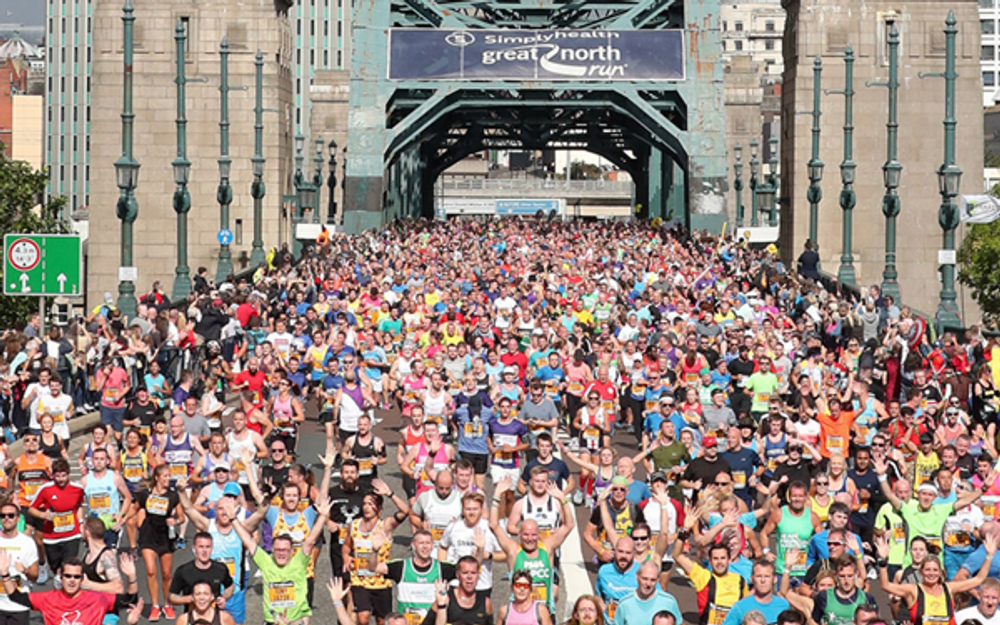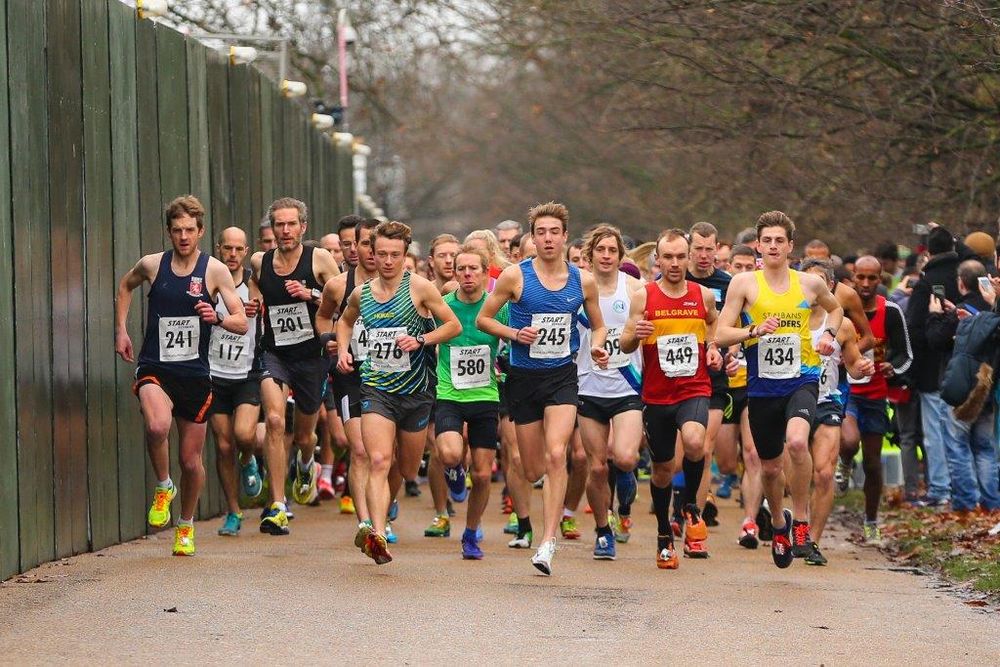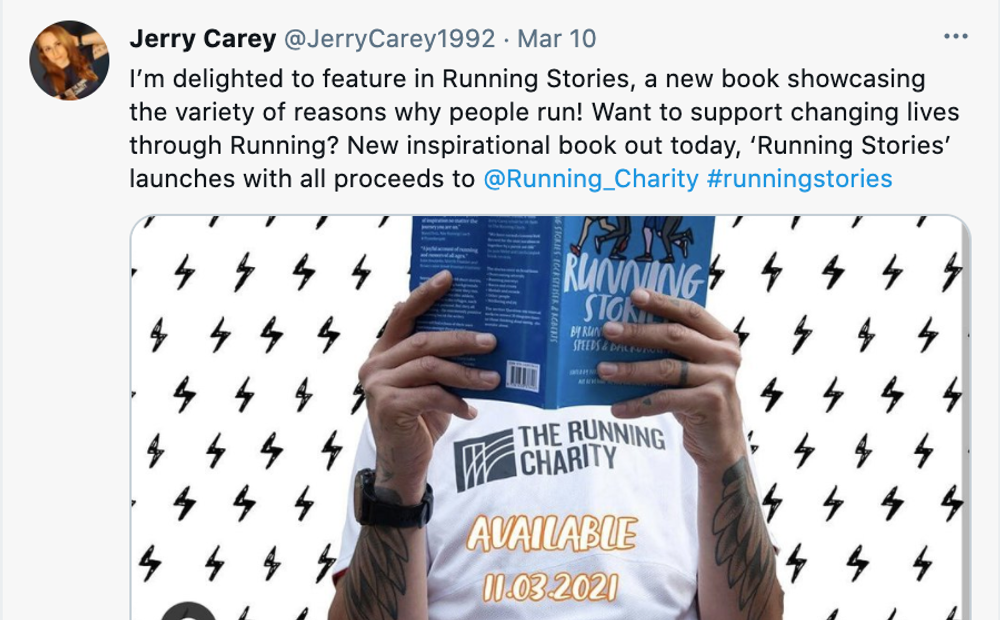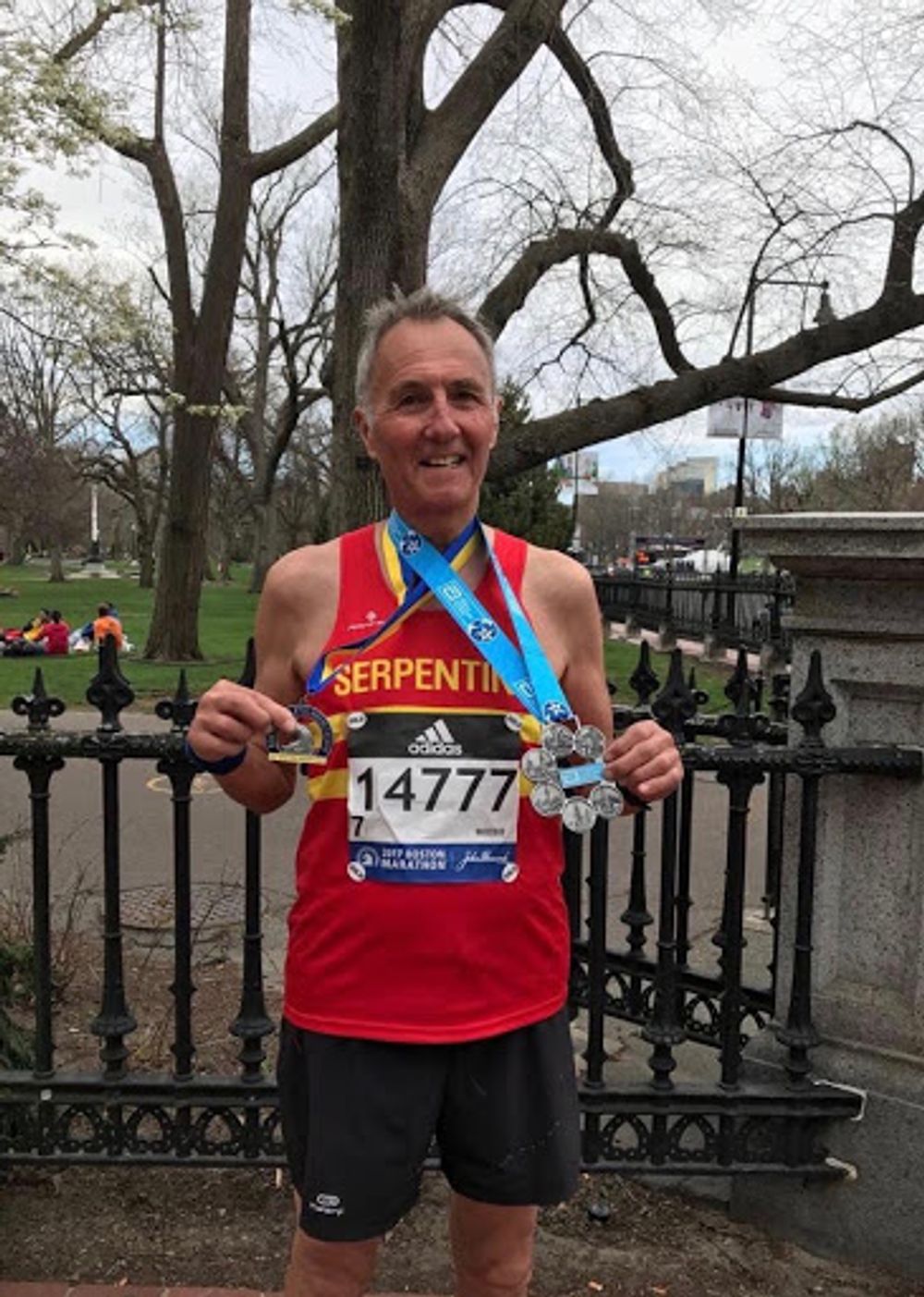Running Stories: By runners of all ages, speeds and backgrounds is packed with inspiring stories to help us get out and start hitting those pavements, says Jerry Lockspeiser.
(Here’s a short video to explain what Running Stories is all about)
As motivational books this is a bit different – how did the idea come about?
I took up running in my mid 50’s when increasingly frequent injuries put paid to my football days. Wine got me into it. Or rather a winemaker – one of my best mates, Nick Butler. He is Australian but his wife comes from the north east and he suggested we do the Great North Run together. This was a first for him too. It’s one of the largest half marathons in the world with around 50,000 participants and goes from Newcastle to South Shields. I was stiff as a plank for days afterwards but adored the community spirit around the event and the diversity of people taking part – every type of runner you can imagine.

Where it all started: The Great North Run was Jerry Lockspeiser’s first serious race he entered
Roll on a decade and I felt like doing another book after Your Wine Questions Answered in 2016. Living under the pandemic many people struggle with mental health issues and need a lift, and I thought it would be inspiring to celebrate the diversity of people who run and the benefits they get from it. A lot of people have started running during the pandemic, and this book shows that anyone can – anyone does – and the wide variety of reasons and benefits they get.
How do you and your co-author Andrew Roberts know each other?

Running clubs, like the Serpentine running club in London, can help you both improve your running style but make life long friends too
Running of course. We are both members of the Serpentine Running Club in central London. We met at a 5k they organise. He is a graphic artist and video maker, a very creative person, and we hatched the idea together. I looked after the words, he looked after the visuals – the design and photographs. I guess there are parallels here with my partnerships in the past with winemakers like Nick.
How did you go about trying to find the stories to include?
We sent out an appeal on social media and through email asking runners of all ages, backgrounds, sizes, and speeds to send us their story. We asked them to write no more than two pages about something special to them associated with running. It might be why they run, about the first time they ran, achieving a specific target, people they run with, a place, race or event that was special to them. Whatever struck them.
How did you decide which stories to include?

Running Stories does exactly that – 88 of them to be exact
It was tough. We received a lot of submissions, mostly from the UK but also from around the world. We made a first selection based on the content and the writing style, and then selected from those to create a balance of different types of story within the book as a whole. We didn’t target a specific number but arrived at 88, each one with a photograph of the writer. I think this is important because seeing an image of the person amplifies their words.
We grouped the stories into six broad themes. These are:
- Running got me through: Extra-ordinary, powerful accounts of overcoming adversity.
- Running journeys: Personal running histories, from getting going to achieving a goal.
- Racing tales: From parkrun to ultra-marathon, these are stories about races.
- The competitive spirit: Winning medals or achieving records.
- It’s about other people too: Making new friends, finding love, raising funds for charity, guiding a blind runner, coaching and much else show that running is far from a solitary experience.
- It makes me feel so good: Stories of wellbeing and joy.

Can you give us some of the examples of the people featured in the book?
This is a tough question because the range is enormous, from beginners to elite athletes, parents at home to refugees, people with physical problems to running coaches. We feature a woman with MS, a blind runner, the owner of an ice cream company, a police inspector, a retired headteacher, two refugees from Ethiopia, a few writers, a Scottish student, a wine consultant, and a prison service manager.
Any of the stories that stand out to you?

Jerry Carey is delighted to be featured in Jerry Lockspeiser’s book
Another tough one as every story has its reason for inclusion. Jerry Carey tells a story that is hard to read, but ends very well. In childhood she experienced abuse, violence, drugs, and foster care before virtual house imprisonment by a vindictive partner as a young adult. A referral by Women’s Aid introduced her to The Running Charity. She says: “…the wonders of running and fitness have changed my life for the better. I am no longer isolated, have control over my anxiety and depression, and have more confidence. I barely recognise the person I was two to three years ago.” Jerry is now studying to become a personal trainer.
Here’s an amusing and inspiring story from Roger Sawtell who started running aged 93 by doing his first 5k parkrun with his family:
“Having staggered across the finishing line in about 46 minutes the race director said, ‘Do you want the good news or the bad news?’ Okay, give me the bad news. ‘You were last in your age group.’ Oh calamity, why don’t I just stay at home and have another cup of coffee for breakfast. ‘However,’ he said, ‘The good news is that you were also first in your age group. We have never before had anyone in the age group 90-94.’ The first to congratulate me was the redoubtable Bob who has completed 377 parkruns, a wonderful record which I will never equal. But he’s a mere 86. We’re all in this together. I was hooked.”
There is a wonderful story by Alun Lucas which starts “We lost a child due to a late miscarriage. We lost a marriage. I lost a job to ‘low mood due to multiple life events’ as the doctor put it.’ He then describes how meeting a new partner and running led to his improvement until: “I kept thinking I feel well. Some weeks later I’d think I feel very well. Again. And I knew I felt better than I had the time before”.
What do you hope the book can do for people?
This book is at root about two things – diversity and positivity. It celebrates both. Whether the story is full of the joy of running in nature, or a hard to read tale of someone escaping from domestic abuse, they all glow with positivity. I hope this book will inspire people – to run and experience the mental and physical benefits – or if not to run, to believe in themselves and their potential, whatever the circumstance.
What does running mean to you and how does it make you feel?
(Jerry Lockspeiser explains in this video from 2016 why running is so important to him and how by being part of The Running School he has been able to improve his style, stamina and satisfaction he gets out of running)
I enjoy running carefree in the park or countryside, allowing a kaleidoscope of thoughts to flow in and out of my mind. It is a kind of meditation, I guess. But I am a competitive type. I love entering organised races both for the atmosphere of being there with everyone else, and to compete – primarily against myself, trying to improve my personal best time, and secondarily to see how I do in my age group against other runners.
Running is now a permanent part of my life. I run four, maybe five times a week, especially when training for a marathon. I have come to realise that the process of entering and training for events, like a marathon, gives me the objective and goal setting that I had when I was ‘running’ a wine business. Preparing for a marathon is a similar mental process to creating a business plan – you need to identify the objective, work out a step-by-step route to achieve that objective, and be flexible enough to adapt when things don’t go as hoped.
Running can also be good for people’s mental health and we have a seen a lot of people suffer during lockdown?

Jerry Lockspeiser at the end of the Boston marathon when he had completed each of the six Abbott Marathon Majors around the world – as his medal on the right shows
You know, I think for most people this is the key benefit, especially during the lockdown but also in easier times. I remember years ago when I felt a bit down at the end of the day I would either swallow a bottle of Entre Deux Mers or go for a run. Both made me feel better for a while, but the EDM made me pay the next morning whereas the run didn’t. In fact, it gave me a good start. More than that, joining a running club is fantastic socially. Many people are members for the social side more than anything. Running clubs like Serpentine are very friendly places suitable for all kinds of runners. I would recommend anyone to find their local club and join up when the pandemic allows.
Any advice on how to make running a regular part of your life?
First, ask yourself why you want to run (perhaps you don’t really, but feel you should). Then make a plan you can stick to that meets your answer. There are stories in the book – often from women – where the writer expresses fear of what others will think of them, or of their ability to do any running at all, even run 100 metres down the street.
They were able to run because they followed a plan – some downloaded the excellent couch to 5K programme that uses a very gradual increase in running and walking over nine weeks to do what it says on the tin; others went with a friend to parkrun on a Saturday morning and made a commitment to go back each week; others joined, or even created, a local group that was about running and sociability, like the stories in the book about the Coffee Runners in Hackney, London.

There are now a number of wine related marathons and half marathons like here at the Denbies Bacchus event
What are you hoping to do with the proceeds from the book?
This is fundamental to why Andrew and I created the book project. We are not taking anything from this, we are donating 100% of our revenue as authors to The Running Charity to support their work with 16–25-year-olds affected by homelessness. They are a small but brilliant organisation doing essential work that literally saves lives. They use running to start relationships with young people affected by homelessness and then use it to build a process of recovering self-esteem and confidence. There are several amazing stories in the book from young people whose lives have been turned around through meeting TRC, like Jerry Carey mentioned before. Apparently, there are over 100,000 homeless young people in the UK, and they are twice as likely to die as their housed peers.
Any other plans for what you might do with this project?
Right now, I am wearing my marketing and sales director hats. We have just launched the book in both print and eBook and made number 1 in the Amazon Athletics category after 48 hours, getting their ‘Best Seller’ tag! But selling books is a marathon not a sprint – a fitting analogy given the content – and my experience selling wine should help me with that. We see this as a 12-month project at least. If we get the traction over the next months, we may bring out a second edition with more stories, or a colour version. Every book sold helps The Running Charity and our distribution is global through Amazon and many other retailers, so we have it all to play for.
Anything else to say?
Can you run? Yes, yes, yes you can. No one is too old, too slow, or too out of shape. The book has a section called Questions New Runners Ask which poses, and answers, 10 common questions new runners, or those thinking of running, often ask themselves. We hope it will help people to cast away any doubts, put trainers on their feet, and feel the thrill at the sound of the front door closing behind them.
Lastly, if someone reading this is not a runner and has no intention of ever being one, this book is for them too. These are extraordinary stories from ordinary people and will inspire everyone.
- Running Stories by people of all ages, speeds and backgrounds is widely available at £8.99 in print and £5.99 in eBook including Amazon, Waterstones, Blackwell’s and independent bookshops in the UK, and Amazon country sites and other retailers globally.










































